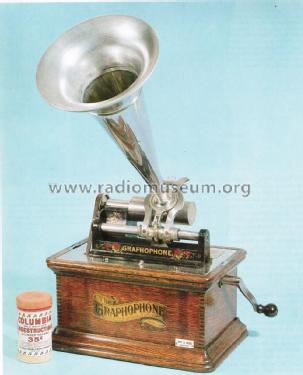- País
- Estados Unidos
- Fabricante / Marca
- Columbia Phonograph, American / Volta Graphophone Company; USA
- Año
- 1905–1907
- Categoría
- Máquina parlante mecánica - gramófono o fonógrafo.
- Radiomuseum.org ID
- 354526
-
- alternative name: American Graphophone || Columbia Recording
- Gama de ondas
- - no hay
- Especialidades
- Otro grabador y/o reproductor
- Tensión de funcionamiento
- Solar / alimentación por manivela.
- Altavoz
- Corneta
- Material
- Madera
- de Radiomuseum.org
- Modelo: Graphophone AZ - Columbia Phonograph, American
- Forma
- Sobremesa de cualquier forma, detalles no conocidos.
- Anotaciones
-
Columbia Cylinder Graphophone type "AZ", 1905. Like its predecessor, the AT, the AZ was roughly the Columbia range equivalent of the "Standard" Edison. The major difference between the AZ and the AT lies in the player, which in the AZ is a "Lyric" more similar to the Edison type of the previous Columbia floating players, but with the stylus held firm in the groove by the tension of the spring rather than by a weight.
Reiss lists this as manufactured from 1905-1907 and cost $25 USD when first introduced and a value of $650 USD in 2007.
Grafofono a cilindri tipo AZ, Columbia, 1905. Come il suo predecessore, l'AT, l'AZ era grosso modo, l'equivalente, nella gamma Columbia, dello "Standard" Edison. La maggiore differenza tra l'AZ e l'AT sta nel riproduttore, che nell'AZ è un "Lyric" più affine al tipo Edison dei precedenti riproduttori flottanti Columbia, ma con lo stilo tenuto fermo nel solco dalla tensione della molla anzichè da un peso.
Reiss lo elenca come prodotto dal 1905-1907 e costava $25 USD quando fu introdotto per la prima volta e un valore di $650 USD nel 2007.
- Mencionado en
- -- Original-techn. papers. (“Fonografi e Grammofoni” by Christopher Proudfoot, Italian edition “Silvana Editoriale” 1980.)
- Documentación / Esquemas (1)
- The Compleat Talking Machine, Eric L. Reiss, 2007 Fifth Ed,. page 145 (photo) and 229.
- Autor
- Modelo creado por Pier Antonio Aluffi. Ver en "Modificar Ficha" los participantes posteriores.
- Otros modelos
-
Donde encontrará 118 modelos, 84 con imágenes y 34 con esquemas.
Ir al listado general de Columbia Phonograph, American / Volta Graphophone Company; USA
